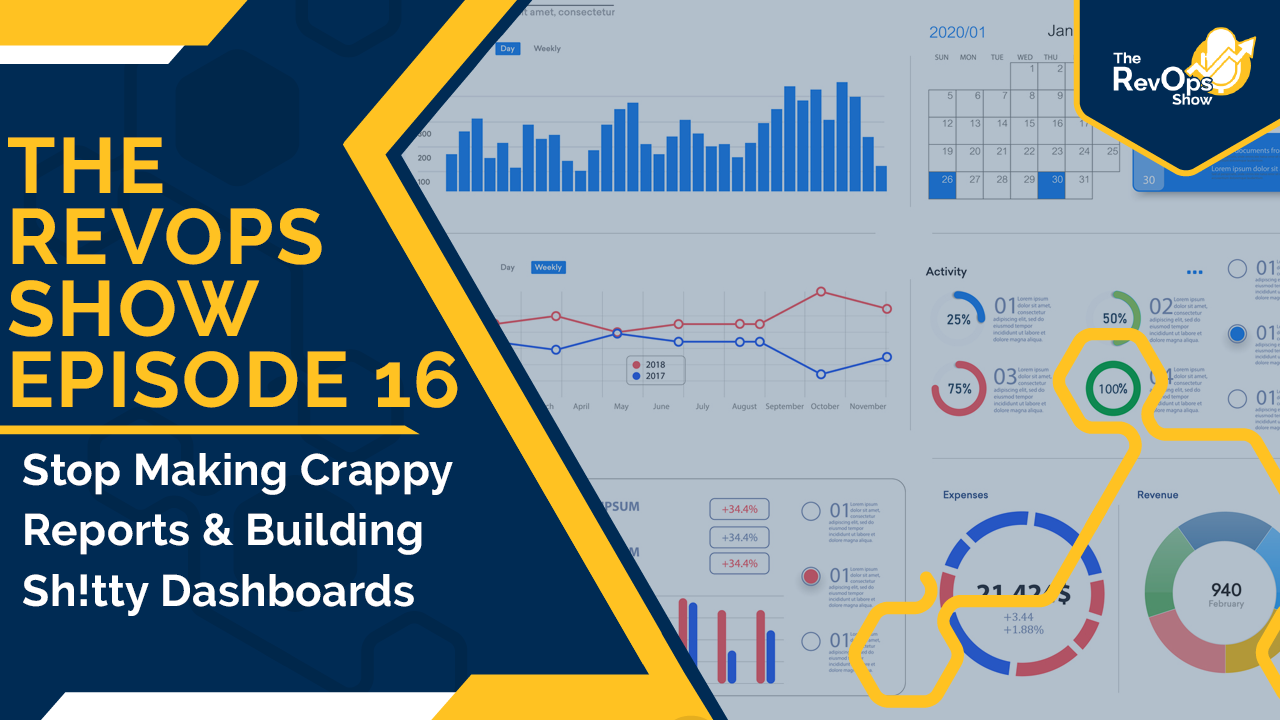Jess is really happy in today’s episode, but will she remain that way? It all depends on if Doug brings out the soundboard. (Spoiler alert: of course he’s going to bring out the soundboard!) Today’s topic is really exciting as Doug finally got to choose what to discuss - dashboards and reporting and more specifically, effective dashboards and reporting.
Audio:
Video:

Additional Resources:
Show Notes:
We start off on a really high note with the topic introduction as Doug thought we were going to talk about ineffective dashboards and reporting. Instead Jess is having him work this episode.
What does an effective dashboard and report accomplish?
By wording the question this way it puts dashboard and reporting on the same plane as if they were synonyms. So, before Doug answers this question, let’s break them out. What makes an effective report?
Doug brings up something that is very HubSpot-y in that this was a designation because it was a HubSpot designation. He thinks we conflate the word report and equate it to something like a view or query. It depends on what system you’re talking about.
What Doug thinks makes an effective dashboard an effective dashboard and an effective report an effective report and an effective view an effective view is, do they make it easier for you to do what you need to do? Does your business increase velocity? Are you able to align your vectors? It asks the question, what is the job to be done? Mistake number one is that far too many dashboards, reports, and views, and fill in the blank in search of a job to be done as opposed to delivering on a job to be done.
The number of times Doug asks someone, “What do you do with this?” Most of the time it’s not for anything important. Most reports are a waste of time because a good report and dashboard gives you a direct line to the signal. It eliminates noise.
You should look at things with the lens of hypothesis, action, result, assess, learn, hypothesis, etc. You need to have an expected result for when you create reports and dashboards. A report is designed to confirm these things, but if you don’t have a hypothesis, how will you know if something is on track or not?
Is there a difference between what we’re trying to accomplish with a specific report versus a specific dashboard?
Yes. The confusing thing here is that, especially in the world of HubSpot, a dashboard consists of “reports.” This is why you have to have clear business process.
How do you put together a strategy for an effective dashboard?
You have activities; Doug calls them efforts. You also have outcomes. Those are controllable elements. You also have results. The problem with efforts/activities is all they do is measure activity. The problem with results is that it’s a rear view mirror because you don’t have control over results.
If you start seeing something that begins to go off course, that’s where reports come in. How you go about designing depends on answering the question of, “what are the key inflection points of your process?”
Why is it so hard to put an effective dashboard together?
There’s the challenge of putting an effective dashboard together and putting effective reporting together. There’s the challenge of actually utilizing it which has a lot to do with a mistake. That common mistake is that Doug sees too many dashboards and reports. Some people have hundreds of reports they want to create because they’re tracking everything. But in doing that they aren’t tracking anything. In Doug’s experience, having too many reports is worse than having too few.
We forget that too much data in front of someone is worse than not enough. Depending on what you’re trying to do, maybe you don’t need a dashboard. People also get confused when they’re creating reports for things they need versus convenience. Are you using this to tell or story, get a specific frame of mind about where we’re at with things or something else?
Start by asking yourself, “What are you doing?” What do you need a report for? What question are you trying to answer? What hypothesis are you testing? One of the biggest dangers about data is that it gives very unreliable answers, but it can provoke great questions. If you’re using data and reporting to answer it works sometimes, but that’s where we can get into trouble.
There are reports that are accessed every week, every day, and sometimes once a month or once a year. Why do we create so many reports then? Because we seek certainty. Data is like a lamppost for a drunk; it’s used more for support than illumination. Over time, if you create enough reports, eventually you are going to be able to find one that tells you what you want to hear. Another reason we have so many is because it’s too easy to make one.
There’s a tendency that we want to show good news with reports, but we should seek to create more reports to show signs of bad news. Good reporting leads to intervention. The biggest challenge for reporting and the way people should look at reporting is it should be a filter. It should filter the noise to give you a more powerful signal. And if your reporting and dashboards aren’t evolving, then you’re not on point.
Next Steps:
-
Follow Jess, Doug & Imagine on socials for updates on the show or other insights:
-
Doug Davidoff: Twitter - @dougdavidoff | LinkedIn
-
Jess Cardenas: Twitter - @JessDCardenas | LinkedIn
-
Imagine Business Development: Twitter - @DemandCreator | LinkedIn
-
-
Subscribe to the show on Spotify & Apple Podcasts
-
Check out Let's Play RevOps on Twitch for more commentary on this topic
